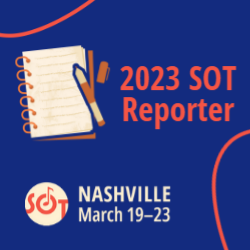
The following summarizes the presentations given during the Workshop Session “A Roadmap to Modernized Agrochemical Carcinogenicity Assessment” that was held as part of the 2023 SOT Annual Meeting and ToxExpo.
Douglas Wolf introduced the session. The rodent cancer bioassay is the current standard approach for assessing human carcinogenic potential for agrochemicals. The length of time, costs, resources, and numbers of animals needed to perform the bioassay have led to the development of alternative approaches to modernize carcinogenicity assessment. Alternative approaches that include weight of evidence (WOE)–based assessment of in vitro, in silico, and short-term in vivo tests have the potential to substantially reduce animal use while still protecting public health and better determining human carcinogenic hazard and risk.
Gina Hilton presented on several organizations that are collaborating in multi-stakeholder initiatives in developing WOE-based approaches and frameworks to support carcinogenicity assessment without long-term bioassays. These initiatives include collaboration under: The International Council for Harmonisation of Technical Requirements for Pharmaceuticals for Human Use (ICH), European Partnership for Alternative Approaches to Animal Testing (EPAA), Organization for Economic Cooperation and Development (OECD) Integrated Approaches to Testing and Assessment (IATA) for non-genotoxic chemical carcinogens, and ReThinking Chronic Toxicity and Carcinogenicity Assessment for Agrochemicals Project (ReCAAP). The common goal of these initiatives is to establish a WOE-based carcinogenicity assessment that could fulfill regulatory needs for chronic safety assessment—without the rodent cancer bioassays.
Patience Browne presented on the OECD Chemicals Programme that develops validated test guidelines for the global assessment of chemical hazards and risks that are mutually accepted by OECD member countries. The principles for building confidence and validating new approach methods (NAMs) in a regulatory context will require sharing experiences and building confidence in such approaches before they are globally implemented in a regulatory context. Through the long-standing OECD IATA Case Studies Project, experiences using NAMs in a regulatory context are shared and reviewed. Plans are to consider a cluster of IATAs addressing potential carcinogenicity of chemicals in a variety of regulatory contexts and using them to draft guidance was discussed.
Deborah Ramsingh highlighted important aspects considered in WOE assessment from the perspective of Health Canada’s Pest Management Regulatory Agency (PMRA). Rodent carcinogenicity studies play a critical role in the hazard characterization of agrochemicals and are a standard data requirement for pesticide regulatory authorities to evaluate the cancer potential of pesticides. Regulators worldwide recognize the importance of reducing animal testing. Regulators may consider using a WOE approach to justify waiving certain in vivo studies for specific pesticides. Examples of three theoretical case studies highlighted important factors considered by pesticide regulators as to whether the cancer bioassays could be waived and illustrated the role that rodent carcinogenicity studies play in characterizing the hazard and risk of pesticides within a regulatory scheme,
Amber Goetz discussed construction of case studies that illustrate how carcinogenicity can be adequately addressed without the bioassay. The collaborative ReCAAP developed a framework to guide WOE evaluation for waiving the rodent cancer bioassays in lieu of their necessity for submission as a data requirement. WOE documents that followed the ReCAAP framework provided a thorough comparative assessment based on comparing data on registered chemicals that were of a similar pesticidal mode of action or shared structural similarity to support the prediction of potential chronic toxicity or tumorigenicity. Key learnings from the case studies and feedback from regulatory agencies serve to improve the framework. To further assess and advance this framework, an OECD IATA Case Studies Project will provide review.
This blog reports on the Workshop Session titled “A Roadmap to Modernized Agrochemical Carcinogenicity Assessment” that was held during the 2023 SOT Annual Meeting and ToxExpo. An on-demand recording of this session is available for meeting registrants on the SOT Online Planner and SOT Event App.
This blog was prepared by an SOT Reporter and represents the views of the author. SOT Reporters are SOT members who volunteer to write about sessions and events in which they participate during the SOT Annual Meeting and ToxExpo. SOT does not propose or endorse any position by posting this article. If you are interested in participating in the SOT Reporter program in the future, please email SOT Headquarters.
#Communique:ScienceNews#2023AnnualMeeting#SOTReporter#Communique:AnnualMeeting